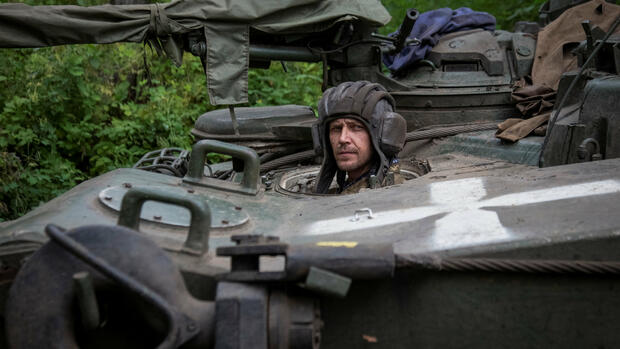Vienna The long-awaited Ukrainian counter-offensive has been underway for a week. Officially, President Volodymyr Zelenskiy speaks only cryptically of “counter-offensive actions”, while some observers speak of “armed reconnaissance”. But the reports from southern Ukraine and Donbass leave no doubt that the fighting has reached a new intensity. Newly trained Ukrainian forces equipped with Western weapons are also taking part for the first time.
According to the Ukraine Conflict Monitor, the attacks with ten brigades were concentrated on the Zaporizhia region. In the middle of last week, the Ukrainians had to call off their attacks south of the city of Orikhiv after suffering serious losses: the 47th brigade lost three Leopard 2 tanks, three heavy mine clearance vehicles and more than a dozen infantry fighting vehicles – technology from NATO countries that was recently delivered to Kiev was.
Further east, on the border of Zaporizhia and Donetsk oblasts, the Ukrainians were somewhat more successful. They liberated five villages south of Velika Nowosilka and recaptured 60 square kilometers of terrain. The troops were able to keep the pressure high on this axis, further advances are possible. In the rural section, the Russian defense positions are apparently somewhat less developed.
The significance of these struggles cannot really be assessed yet. It remains unclear where Kiev will put the main push. Both Russian and Ukrainian military experts point out that the weekend’s successes were also linked to the bad weather, which made it difficult for the Russians to use their air superiority.
Even though the Ukrainians have so far kept most of the Western equipment in reserve, the footage of burnt-out Bradley armored personnel carriers is causing nervousness: They show that the number of combat machines delivered is limited; in a battle they can be quickly destroyed.
Russia distributes videos of destruction in endless loops
Moscow is spreading the images of the Ukrainian backlash with great enthusiasm. Videos of the destroyed vehicles run in endless loops on social networks. They are shown from different perspectives to give the impression that they came from more than one place. At the same time, there is talk of dozens of tanks being destroyed – propaganda that some of the world public uncritically believes. President Vladimir Putin has already declared the counter-offensive a failure. You have not achieved any of your goals.
Kiev has therefore recently put its silence on the course of the offensive into perspective. The head of the military intelligence service, Kirilo Budanov, published a video on Sunday in which he sat silently in his office for 30 seconds before the text “Plans like silence” is displayed. But military spokesmen celebrate every unknown village that changes hands, and in turn propagate countless videos of flag-waving Ukrainian soldiers.
On the one hand, the Ukrainians want to give as little information as possible so as not to warn the Russians. However, given the logical attack axes, there is no real surprise effect. However, in order to reassure its own population and its western partners and to justify the losses, Kiev needs reports of success.
These contradictions are not new, but were already evident in the successful offensives of the past year. However, the breakthroughs in the Kharkiv region came quickly and unexpectedly. In Cherson, on the other hand, practically no information about the months of bloody fighting reached the public. Today, impatience abroad and the pressure to succeed are much higher.
Ukraine has partially expanded its communications on the counteroffensive.
(Photo: AP)
This has to do with the growing skepticism and domestic political pressure in various western partner countries, but also with the extremely high expectations that Zelenskiy has fueled in Ukraine. He sells the offensive as the decisive liberation that should bring back all areas occupied by Russia since 2014. In view of the limited possibilities, this is politically and militarily risky and does not allow any relativization or gradation.
Slight Ukrainian successes are considered unlikely
However, experts consider slight success to be unlikely, since the Russians had a lot of time to prepare. In addition, they remain superior to the Ukrainians in manpower and material, especially in tanks and the air force. Higher motivation and better tactics make up for these deficits at most partially. The ongoing partial mobilization also means that a Russian counter-offensive cannot be ruled out in the foreseeable future. Kiev must also keep this in mind.
Western analysts who are friendly to the country are also questioning whether the Ukrainians will have the strength to achieve all of their goals. Two American advisers to the army in Kiev recently expressed skepticism as to whether rapid Western training has eliminated deep-seated Soviet traditions in military leadership. The latter include the lack of cooperation between different branches of service and strict hierarchies that impede quick decisions at the front.
The offensive is now forcing the Ukrainians, under great pressure, to carry out extremely complex operations with which they have little experience. A breakthrough is rather unlikely: The Finnish Osint specialist Emil Kastehelmi points out that the Russian main lines are more than a dozen kilometers away from the front, despite the Ukrainian successes at the weekend.
At the same time, until now, the bulk of the newly trained and trained brigades remain in reserve. “The main course is yet to come,” writes a somewhat more optimistic observer.
More: Follow all developments in the Ukraine war here in the live blog
